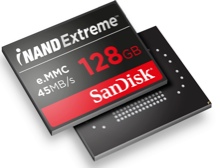SanDisk enhances iNAND Extreme flash storage for Atom Z3000 'Bay Trail' SoC


Now that Intel has die-shrunk the Atom architecture in the Bay Trail SoC, SanDisk is looking to improve storage performance by upgrading its iNAND Extreme flash chips.
The company is currently in the process of sampling the iNAND Extreme to leading mobile device manufacturers for use in Android and Windows 8 tablets powered by Intel's Atom Z3000 processors.
Enhanced iNAND Extreme specifications are as follows.
- Capacities: Ranging from 8GB to 128GB
- Interface: e.MMC 4.51 HS200
- Sequential read/write speeds: Up to 45/150 MB/s
- Random read/write speeds: Up to 800/4K IOPS
"We are pleased to offer the tremendous storage performance of SanDisk’s iNAND Extreme for use in tablets incorporating Intel’s impressive new Intel Atom platform," said Drew Henry, senior vice president and general manager, Mobile and Connected Solutions, SanDisk.
Featured
"We have clearly just scratched the surface of the potential for tablets to transform the user experience, and our iNAND Extreme enables developers to introduce the next wave of highly responsive tablets that offer richer entertainment, awe-inspiring graphics, and more productive business applications."
SanDisk, it seems, is planning to ride the wave of increased tablet sales predicted by analysts, which are expected to hit 180 million by the end of the year.
"Robust consumer demand for more convenient and better mobile computing options has driven rapid growth in the tablet market, with branded tablet shipments up nearly 55 percent worldwide in 2013 compared to last year," said Peter King, director of Tablet & Touchscreen Strategies at Strategy Analytics.
"Notable advancements at the semiconductor level pave the way for a new generation of tablets that offer longer battery life, more responsive digital entertainment, and computing experience that is more closely aligned with what was once only possible on a PC."
UPDATE: Stats updated as incorrect data was sent in press release.